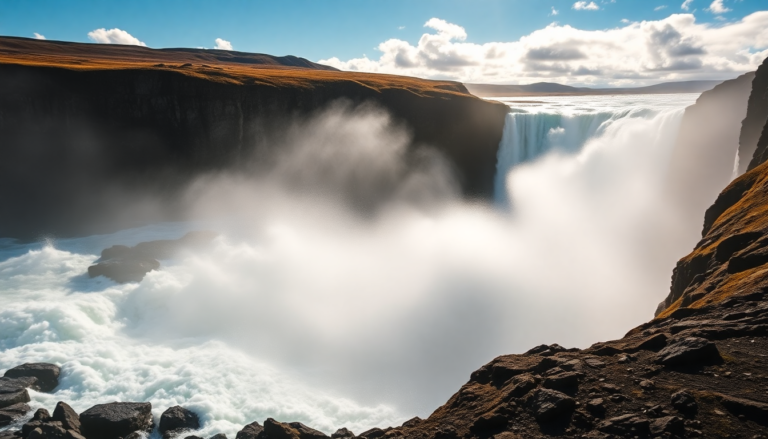Argomenti trattati
There are moments in life that take your breath away, and standing before Dettifoss waterfall in northern Iceland is undoubtedly one of them. Known for its sheer power and beauty, Dettifoss isn’t just a waterfall; it’s a testament to nature’s raw force. As the water plunges dramatically from a height of 45 meters, the roar fills the air, leaving visitors in awe of its might. This majestic cascade, fed by the melting waters of the Vatnajökull glacier, is the most powerful waterfall in Europe and a bucket-list destination for travelers seeking adventure and wonder.
Getting to know Dettifoss
To truly appreciate Dettifoss, one must embark on a journey through Iceland’s rugged terrain. The waterfall is situated within the Vatnajökull National Park, the largest national park in Iceland. This park isn’t just about Dettifoss; it’s a sprawling wilderness of glaciers, volcanoes, and unique ecosystems. The Jökulsá á Fjöllum river, which feeds the waterfall, is responsible for carving the dramatic canyon of Jökulsárgljúfur, where Dettifoss is located. The experience of seeing the water cascade down, coupled with the surrounding landscape, feels almost otherworldly.
However, reaching Dettifoss isn’t as straightforward as one might think. The journey requires a little grit and determination. Nestled away from the well-trodden Ring Road, the approach involves venturing along gravel roads that can be challenging, especially in winter when snow covers the path. Trust me, I remember my own trek to this magnificent site, the excitement bubbling up as I navigated through the wild Icelandic landscape. It’s best to plan your visit during the summer months, when the roads are more accessible and the scenery is a vibrant tapestry of green and blue.
Surrounding wonders and experiences
But Dettifoss is just the beginning. As you explore the area, you’ll find two other stunning waterfalls that should not be missed: Selfoss and Hafragilsfoss. Selfoss, located upstream, presents a series of elegant cascades that flow gracefully along the canyon’s edge. It’s a quieter spot, yet equally mesmerizing, with a more intimate feel. Then there’s Hafragilsfoss, which, while smaller, offers its own charm and beauty, providing a perfect backdrop for photography enthusiasts.
While in the vicinity, don’t forget to visit Akureyri, often referred to as the ‘Capital of the North.’ This charming town is a hub of culture and activity, complete with cozy cafés, intriguing museums, and a lively atmosphere that captures the essence of Icelandic life. You can easily spend a day here soaking up the local culture, mingling with the friendly locals, and perhaps even sampling some traditional Icelandic cuisine.
Whale watching in Húsavík
Just a short drive from Akureyri lies Húsavík, a quaint fishing town that has gained international fame for its incredible whale-watching opportunities. Every summer, the waters off Húsavík transform into a playground for various whale species, including majestic humpbacks and playful dolphins. I can still remember the thrill of seeing a humpback breach the surface, splashing water in a glorious display. These excursions are not just tours; they are unforgettable experiences that connect you with the sheer magnificence of marine life.
The enchanting Lake Mývatn area
Moving on, the Lake Mývatn region is a geological wonder that beckons nature lovers. This volcanic lake is renowned for its astonishing biodiversity, particularly for birdwatching. As many know, Mývatn is a haven for rare duck species, making it a paradise for birdwatchers. Yet, it’s not just the avifauna that captivates visitors; the landscape boasts intriguing geological formations, such as craters and lava fields, giving it an otherworldly vibe.
Among its many features, Dimmuborgir stands out with its striking lava formations, which locals believe are home to the infamous Icelandic Yule Lads—thirteen mischievous trolls that add a whimsical touch to the folklore of the region. This area, with its rich stories and unique landscape, has even served as a backdrop for popular films and series, including scenes from “Game of Thrones.” It’s fascinating how nature and storytelling intertwine here.
A visit to Goðafoss
Before heading to Mývatn, a stop at Goðafoss, the ‘Waterfall of the Gods,’ is almost mandatory. Although it may not be as powerful as Dettifoss, it carries a spiritual significance that resonates deeply. Legend has it that this was the site where Iceland’s conversion to Christianity was symbolically marked—pagan idols were cast into its waters, marking a new beginning. Standing there, feeling the mist against my face, I couldn’t help but reflect on the historical weight of this serene spot.
Mythical Ásbyrgi Canyon
Finally, just north of Dettifoss lies Ásbyrgi, a stunning horseshoe-shaped canyon that feels like a scene from a fairy tale. According to local legend, the canyon was formed by the hoofprint of Sleipnir, Odin’s eight-legged horse. It’s a lush oasis, teeming with vegetation and wildlife, offering a serene contrast to the rugged landscapes typical of Iceland. Walking through Ásbyrgi feels almost magical, as if the myths of old are alive in every shadow and whisper of the wind. The blend of myth and nature creates an enchanting experience that lingers long after you leave.
In essence, Dettifoss and its surroundings are a treasure trove of natural beauty, adventure, and cultural richness. From the roaring cascades to the quiet whispers of ancient legends, every corner of this region tells a story worth discovering. So, pack your bags, grab your camera, and prepare for an unforgettable journey into the heart of Iceland!

